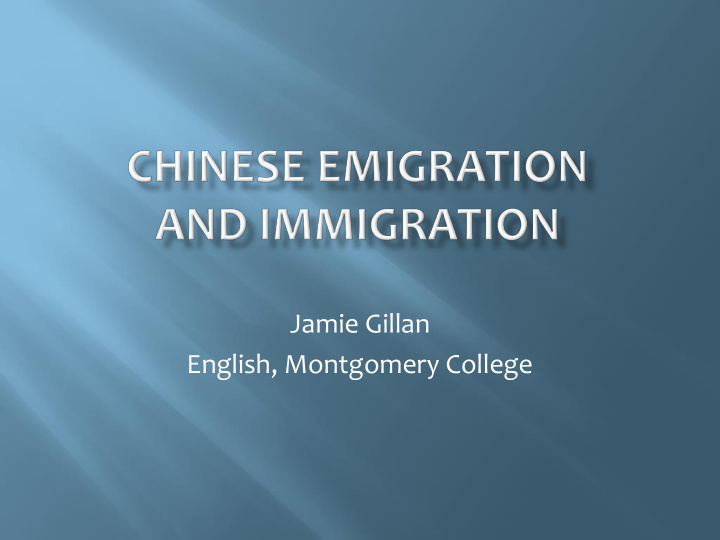



Jamie Gillan English, Montgomery College
Just as the waves in the sea are ever seething and multi-directional in their unpredictability, so too is immigration Immigration and emigration are “mind -meltingly complex” in history and scope Some highlights included in this presentation: Current Emigration Recent and current Immigration Brief History of Chinese Immigration to the US
Half of the “super rich” (assets over 100 million yuan) are considering emigration 14% are in the process Why? Children’s Education Safety of Wealth Preparation for retirement To a lesser extent, social progression This is causing some concerns about lost talent and the stability of the economy. Source--CCTV
The Economist claims Chinese immigration to Africa is “mass” “Chinese diaspora” Accurate estimates are impossible, but perhaps one million people or more have moved to Africa in the past decade Why? Big Chinese company contracts Bring own people to do menial jobs
Why else are the Chinese moving to Africa? Chinese companies and investors are buying raw materials As a result, large numbers of the lowest socio-economic populations are moving to Africa, in addition to a few of the very wealthy The Chinese and the Africans are not embracing one another, a wary racism pervades
Immigration policy from 1985 to 2012 was very open. Even though China has historically been a nation of emigration, immigration has increased 35x since 1985 However, the immigration numbers are still very low in comparison to our US conception An expanding economy and low cost of living make living there attractive --Source: Migration Policy Institute
According to the Migration Policy Institute, in 2010 there were 594,000 immigrants living in China. (Small compared to 1.35 billion population) Where are the immigrants coming from? North Korea US Japan Burma Vietnam Africa (individual nations not parsed out) This is also an interesting population because there are many students from African nations studying in China. Think: old political ties Traditional migrant populations from Africa exist, too
Economic Consequences: Overwhelmingly positive Assist in their export trade Foreign talent adds value Tourist and foreign students bring income Social Consequences: Growing concerns about “low - quality” immigrants coming from North Korea and Vietnam Perceived social instability
Similar to the US, it’s complex! There is now an immigration fast track for talented professionals and those with family ties Political Asylum now exists! Undocumented Immigrants: Officially--monetary fine and potential incarceration for: working illegally illegal entry overstaying one’s visa Unofficially--these penalties are unevenly applied to immigrants, depending on country of origin and economic status , among other factors
Some migrants, especially the poor and undocumented, get trapped in the system! A Catch-22 can exist: Exit visa with housing registration needed to leave However, to register for housing, valid travel documents needed Results: I t’s expensive and timely buying forged documents OR paying the fine and enduring jail time In addition to country of origin, economic status, etc., the rules are not applied evenly throughout the country.
Voices from the Bottom of the South China Sea: The Untold Story of America’s Largest Chinese Emigrant Disaster by Robert S. Wells Most immigration pre-1882 is via Hong Kong from the Guangdong Province They entered the US through San Francisco Credits for Book and Info: Cedric Yeh,Deputy Chair, Division of Armed Forces History at National Museum of American History, Smithsonian Functionally, a Chinese-American culture and immigration expert
Between 1867-1881, over 100,000 Chinese immigrants where shipped to the US As many as 1200 immigrants on a single boat Menial labor jobs: Mining Railroad construction Gold Rush support (i.e. servants, laborers) Source: South China Sea reading
The Chinese immigrants were not well treated upon arrival “John, as the Chinese were called, ‘is an inveterate smuggler, and is a perfect adept at all kinds of tricks to further the nefarious trade.’” --customs officer “Special consideration was taken with the 30 [of 1200] women passengers…they were held aboard under suspicion that they had been sent for purposes of prostitution.” Eventually the shipping company fought to have the women released Source: South China Sea reading
The Exclusion Act of 1882 forbade any Chinese citizens from immigrating to the US Only time in US history that people from a specific nation are barred from entry The Exclusion Act was preceded by fear driven thinking like this… “The Chinese labor question is destined within the next ten years — five years perhaps — to become what the slavery question was a few years ago, to break down, revolutionize and reorganize parties, completely change the industrial system of many of our States and territories and modify the destination of our country for generations to come.” --Atlantic Monthly, Nov. 1869 Sound familiar…?
The Exclusion Act was repealed in 1943 During WWII, we need allies against the Japanese This is the impetus for the repeal Congress did eventually apologize… in June 2012 ! Hart Sellar Act (1965): Immigration gets easier for everyone outside of Western Europe/North America (at least for a while)
WWI —Shipped “helpers” from China, across Canada, over the Atlantic, to the Western Front Large numbers of Chinese in Peru
Migration Policy Institute Voices from the Bottom of the South China Sea: The Untold Story of America’s Largest Chinese Immigrant Disaster – Robert S. Wells The Economist CCTV (China Central Television) Cedric Yeh The Wave – Susan Casey
Recommend
More recommend